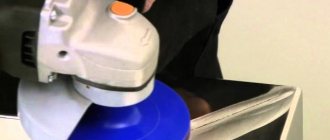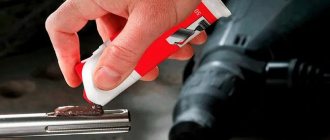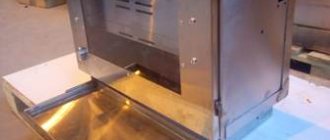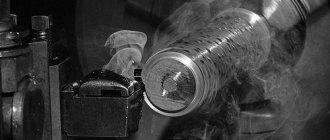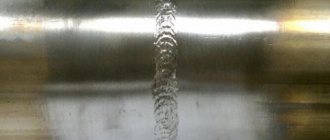- 1000 x 2000 mm
- 1250 x 2500 mm
- 1250 x 3000 mm
- 1500 x 3000 mm
The maximum size of the workpiece after laser cutting is 1490 x 2990 mm.
To ensure a clean cut and no scale, laser cutting of stainless steel occurs in a nitrogen environment. This technology will allow you to obtain a smooth, shiny end of the workpiece.
When laser cutting sheets with protective film, we use evaporation technology. The laser beam moves at a higher height than with conventional laser cutting of sheet metal and creates a fairly wide slit in the film. This allows you to save the front side of the sheet from scratches and other damage during subsequent machining. We work with both our own and customer-supplied metal.
| Thickness (mm) | Length of circuit up to 100 m | Circuit length from 100 to 500 m | Circuit length from 500 to 3000 m | Contour length over 3000 m | Cost of one plunge (rub.) |
| rub. | rub. | rub. | rub. | ||
| 0.5-0.8 | 55 | 40 | 38 | 18 | 1 |
| 1.0-1.2 | 60 | 42 | 40 | 21 | 1 |
| 1.5 | 90 | 65 | 60 | 28 | 1 |
| 2.0 | 115 | 75 | 70 | 33 | 1 |
| 2.5 | 140 | 85 | 78 | 39 | 1 |
| 3.0 | 158 | 130 | 120 | 48 | 2 |
| 4.0 | 200 | 160 | 150 | 61 | 2 |
Methods for cutting stainless steel
The material in question belongs to alloy types of steel, which are not afraid of contamination and exposure to liquids, since they do not become rusty. The composition of the steel is complemented by a high content of chromium, as well as hardeners - titanium, tungsten, iron molybdenides. Thanks to this, on the one hand, the durability of the metal is achieved by increasing strength; on the other hand, it complicates the cutting process. However, there are several ways to qualitatively divide metal into small pieces.
There are two cutting groups:
- mechanical (the workpiece is cut with a sharp hand tool);
- thermal (due to exposure of the metal to high temperatures, leading to its melting).
The advantage of the first method is that the master will not need expensive equipment. The disadvantage is the need for physical force and a lot of time. Therefore, thermal cutting methods are becoming very popular today.
These include:
- gas arc cutting;
- by electrical erosion;
- waterjet;
- laser;
- plasma.
The features of each type of material processing are discussed below.
Scope of application of stainless steel
Stainless steel or simply stainless steel is rightly considered one of the most common structural materials. This is achieved through an impressive set of technical and operational qualities, the main ones being strength and long service life.
The result of this set of advantages is an extremely wide range of practical applications of stainless steel. It includes:
- chemical and food industries;
- pulp and paper production;
- electric power industry;
- all types of mechanical engineering;
- construction, renovation and architecture;
- furniture manufacturing;
- different areas of environmental activities;
- medicine, research and scientific laboratories and centers
Oxygen cutting
Better known as “gas arc cutting”. As in other cases, processing involves the use of special equipment. Its working part - the arc - comes into contact with the workpiece, after which deformation of the cut layer occurs.
Arc cutting is performed with consumable and non-consumable electrodes. The first includes steel, the second - graphite. To increase the efficiency of work, air (air-arc cutting) or oxygen (oxygen-arc cutting) is supplied to the arc zone.
The advantages of the method are the availability of equipment and the low cost of it (or work). But there are more shortcomings. Among them:
- violation of the integrity of the metal;
- poor cut quality;
- low productivity.
The process of arc cutting stainless steel is now considered obsolete as more efficient methods have replaced it.
Electrical erosion method
The method is based on the use of an electric discharge pulse, which tears out microparticles from the surface of stainless steel. Erosion installations have a pair of electrodes immersed in a liquid dielectric, which, when approached, pierce it and lead to the appearance of a discharge. High temperature plasma is formed in the channel of the latter.
The advantages of the method are high precision processing of parts, as well as the ability to cut workpieces up to 40 cm thick. Disadvantage: low speed.
Our advantages
Among the basic advantages of the proposed cooperation, it is important to highlight two main ones. The first is the quality of metal processing, proven by the successful operation of the enterprise since 2008 and confirmed by the opinions of numerous customers.
The second is a reasonable price level. It is complemented by a personalized approach to each client, which is expressed in additional preferences for regular and large customers.
Other important advantages of using our company are as follows:
- efficiency of order execution;
- flexible cooperation scheme, most of the parameters of which are determined by the customer himself;
- guarantee of the quality of the work performed.
A bonus is the provision of related services: development of design documentation, processing of various metals, their welding and bending, as well as powder painting. We are ready to discuss the terms of cooperation and promptly answer any questions.
Waterjet method
The action consists of supplying liquid through a sapphire, diamond or ruby nozzle 1/10 mm wide. The emerging jet accelerates to a speed three times the speed of sound, after which the thin, concentrated jet is capable of cutting durable materials, including stainless steel. For soft workpieces, clean water is used; for harder ones, abrasive elements (sand) are added to it.
The speed of modern installations is high, so they successfully compete with laser and plasma machines. For example, the Dekart W2040 L device cuts up to 8 m of metal per minute (depending on the thickness); in the case of stainless steel, the figure is usually 2-3 m/min.
An interesting fact: in the West, studies were conducted to determine the effectiveness of waterjet and laser machines. To do this, dozens of plates with a thickness of 0.3 mm each were cut. It was found that for a package up to 6 mm thick, laser is more effective, and for packages over 6 mm thick, waterjet is more effective.
Advantages of the method:
- stainless steel does not heat up during operation;
- the likelihood of workpiece deformation is reduced;
- high quality of cut;
- minimal loss of material;
- speed of work;
- minimal process error (cut width is 10 times thinner than with arc cutting).
Flaws:
- high cost of equipment (a standard waterjet machine will cost the user 3 million rubles or more);
- rapid wear of working parts.
Cutting stainless steel with a jet of water is considered a promising processing method.
Order a service in Moscow
carries out processing of stainless steel using the water-cutting method according to any customer’s sketches to order. The price of the service is from 69.90 rubles/m. In this case, the minimum order value starts from 5,000 rubles. You can find out the exact cost of the order from our managers at +7 (495) 601-94-03 +7 (495) 601-92-59 or we recommend filling out an application to calculate the cost of the service provided.
The use of modern high-precision equipment, qualified personnel and extensive experience in the field of metal cutting is what distinguishes MetalProcess (Moscow) from other companies providing similar services.
We guarantee each client an individual approach and high quality waterjet cutting of stainless steel. You don't need to search for the necessary material - we use our own metal! We will also deliver finished products within the agreed time frame free of charge.
Laser cutting
Advanced and one of the two most popular methods of material processing. Cutting involves the impact of a thin laser beam on steel. This impact is positive for a number of reasons:
- productivity is high;
- cutting width - from 0.1 mm;
- no dynamic or static local stresses;
- high surface quality in the cutting area.
An interesting fact: in the production of road equipment at Vermeer (USA), there are only two devices for dividing metal into parts - these are laser cutting machines with a productivity of 25 tons/day. This scope of work satisfies the requirements for process efficiency.
Laser cutting of stainless steel is possible only for workpieces less than 20 mm thick. This is a consequence of the low laser efficiency - only 15-20%. But the advantages of the installation outweigh its disadvantages:
- contactless cutting (on modern models);
- error - no more than 1/12 mm;
- minimal likelihood of burrs;
- There are no deformations along the cutting line;
- marking of stainless steel workpieces is carried out without human intervention according to the finished project;
- work time is minimal;
- constancy of the physical properties of the workpiece being processed.
A small minus is that after work, a trace of high temperature remains near the cut, so subsequent mechanical processing is required.
Features of waterjet cutting technology
The principle of water cutting technology is the erosive effect on stainless steel of a high-speed mixture of water and high-hardness abrasive particles. Under the influence of a thin powerful jet, particles of material are torn off and removed from the cutting cavity. There is no heating of stainless steel and no scale formation on the cutting edges.
Stainless steel is a metal that is difficult to cut. Therefore, water cutting of stainless steel is carried out using garnet sand. The stability of the jet and the effectiveness of its impact on the material is ensured by automatic control of various cutting parameters, which are supported by high-tech equipment
Plasma cutting
The technique was developed about half a century ago and immediately eliminated the disadvantages of gas-arc equipment.
The principle of operation is partly similar to that previously discussed - a compressed electric arc intensively melts the stainless steel along the cut line, and the remaining liquid metal (“splashes”) is removed from the surface by a fast plasma flow. The speed of the operation is impressive - the plasma has a temperature of 15-20 thousand degrees (versus 1800 degrees for a conventional arc), so the productivity of work is several times higher. Plasma cutting of stainless steel is recognized as the best processing option. It does not require gas cylinders, additional chemicals, or special fire safety requirements for the premises. To operate, you only need electricity, air and inexpensive consumables - electrodes and nozzles. This makes plasma the most cost-effective method for cutting stainless steel.
The technique has only one drawback - the cut edge is not very smooth, requiring additional processing. However, the surface quality along the cut line is much higher than with arc machining.
The higher the thermal conductivity of the material, the thinner the part the plasma processes. For example, the permissible thickness of copper should be lower than the maximum thickness of stainless steel, all other cutting conditions being equal.
When processing workpieces thicker than 200 mm, it is recommended to use gas-arc cutting.
Mechanical methods
Even an experienced user may never have encountered the listed equipment, because it is very expensive and is found only in enterprises. However, there are methods that are in no way inferior in efficiency to plasma, hydraulic and even laser cutting of stainless steel. Some of them, as well as the subtleties of work, are given below:
- Bulgarian. A working method, but the stainless steel should not heat up. To do this, water the cut area. An increase in disk life will also be achieved.
- Metal scissors. The method is only suitable for very thin stainless steel sheets (0.5-1 mm).
- Circular saw for metal. Instead of a toothed disk, a cutting abrasive disk is installed (as on an angle grinder), and some kind of stop is placed on the sheet to be cut. The downside is the impressive consumption of the wheel, and if the adjustment is incorrect, the workpiece is pulled to the side and the cut is disrupted.
Treated stainless steel sheets can be bent, stamped, polished, painted, welded, etc. There are many ways to divide large workpieces into small ones, and it is up to you to decide which one is more effective. The best option for home use is an angle grinder; for industrial use, cutting stainless steel with a laser or plasma is acceptable.
If you know other ways to process alloy steel or notice an inaccuracy in the description, please share the information with readers.
How to choose a machine
First of all, you need to decide on the tasks that you would like to solve using a metal laser machine. Calculate the volumes of material processed per month and year to determine the required effective productivity. Accuracy requirements and tolerances. All this at the initial stage will provide the basis for economic calculations and understanding of the nominal productivity of the machine and related equipment.
Based on production needs, machine components are selected, such as:
- Bed . The design of this unit and its parameters are the most important in the production of the machine. All structural elements are installed directly on it, and the declared accuracy will be determined by its rigidity and strength.
- Laser source. There are many manufacturers offering sources ranging from 500 to 120,000 watts. Power is not the only indicator that must be taken into account when choosing. There is also an indicator of the accuracy of the output power, a specified resource for drawdown during a long period of operation, “efficiency from the socket,” warranty, service, etc. The most common brands of laser sources: IPG, Raycus, Max, nLight.
- Laser head . The element that delivers the full power of the laser to the material. Its capabilities determine the functionality of the processed materials and the quality of cutting. There are heads with manual and automatic focal length adjustment. In terms of functionality, they differ within the shape of the workpiece and the ability to get into difficult places. The main laser heads supplied are: RayTools, SWX, Precitec.
- Control system. System capabilities, in addition to the basic functions, must have functions to facilitate basic operations, such as: determining the position and shape of the workpiece, collision protection, optimization of drawings, auto-layout, etc. The market is dominated by: CypCut and its budget version CypOne, as well as NcEditor (aka Bodor Pro 2).
- Periphery. The machine can work without this, but its presence greatly simplifies the work and reduces time costs. Peripherals include rotating devices, chillers, table changers, protective booths, cranes, levelers, workpiece fasteners, roll-out carts, exhaust systems, etc.


